|
MONDAY EDITION December 15th, 2025 |
|
Home :: Archives :: Contact |
 |
Oil Market updateClive Maund www.clivemaund.com support@clivemaund.com March 11, 2008 With oil having at last broken clear above $100 a barrel over the past couple of weeks and risen as high as $106, there is a widespread view in some quarters that it has established itself above this level and will now stay above it. According to our analysis, this view is probably mistaken. One big reason cited for the strength of oil in the recent past is it moving to compensate for the weakness of the dollar. If this is the case it of course implies that should the dollar to decide to go up for once instead of just down, the oil price will go into reverse, and it just so happens that with the dollar now deeply oversold, that is precisely what is likely to happen. Gold and silver are extremely overbought and appear to be topping out ahead of a dollar rally, and if this is what transpires it seems highly improbable that oil will continue to advance at the same time.
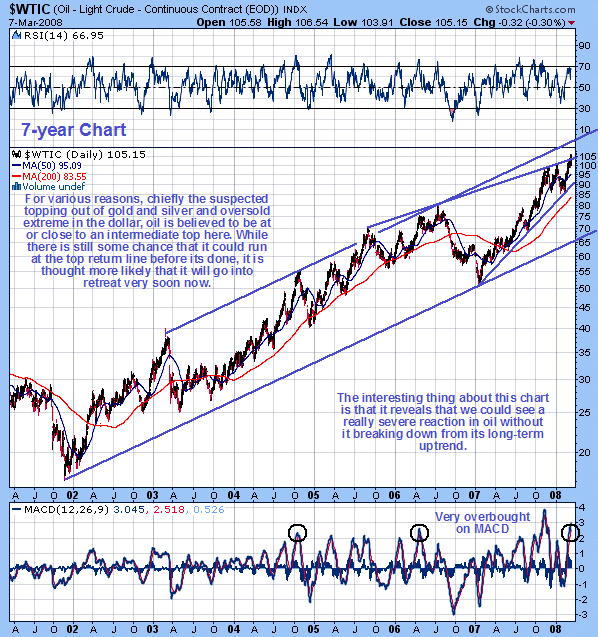 On the 7-year chart for Light Crude we can see that oil is in a long-term uptrend that began late in 2001. Within the long-term uptrend channel we can also see the steeper intermediate uptrend that began early last year and remains in force, and which has propelled the price towards the upper boundary of the long-term uptrend channel. It can be seen that a trendline drawn across the 2005 and 2006 peaks gave a target for the advance last year, and held the price in check on 3 occasions when it attempted to break through it - so this line is important. With last week’s jump to $105 - $106 it would appear at first sight that the price has broken above this restraining influence, but although it has, it has not done so by a convincing margin and so it might be a false breakout, and given the factors mentioned in the paragraph above, that is what it is believed to be, and if so we are at an intermediate top right now. If it is a valid breakout then the price could soon run at the upper parallel channel return line, currently at about $120. The MACD indicator at the bottom of the chart shows oil to be very overbought - more so than on any other occasion except November last year - it still has some way to go to equal that peak. This is an additional important factor suggesting that a reaction is likely soon. Before leaving this chart it is worth observing that oil could react really heavily from here back towards $70 - $75 without violating its long-term uptrend.
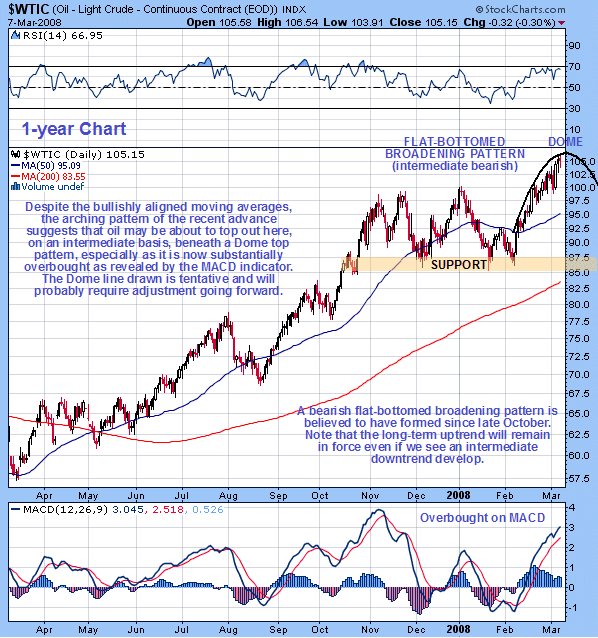 On the 1-year chart for Light Crude we can examine recent action in more detail. At first glance everything looks OK with the price romping ahead to new highs and its moving averages in bullish alignment, but on closer inspection there are signs that a heavy reaction may be in the offing. In the first place the series of higher highs since early November with intervening reactions down to the same horizontal support line has created what looks like a bearish flat-bottomed broadening formation. Secondly, the steep rise from early February appears to be losing momentum and arching over, enabling us to draw a tentative Dome resistance line over the top of it. This Dome is a distribution pattern, and if the current boundary is correct (it may require adjusting with time) then oil is at an intermediate peak right now, which would make sense if gold and silver are topping out and the dollar is putting in at least a short-term low. Finally, as already observed on the 7-year chart, oil is very overbought at this point as shown by the MACD indicator, which, were it not for the early November peak reading, would be at a record level.
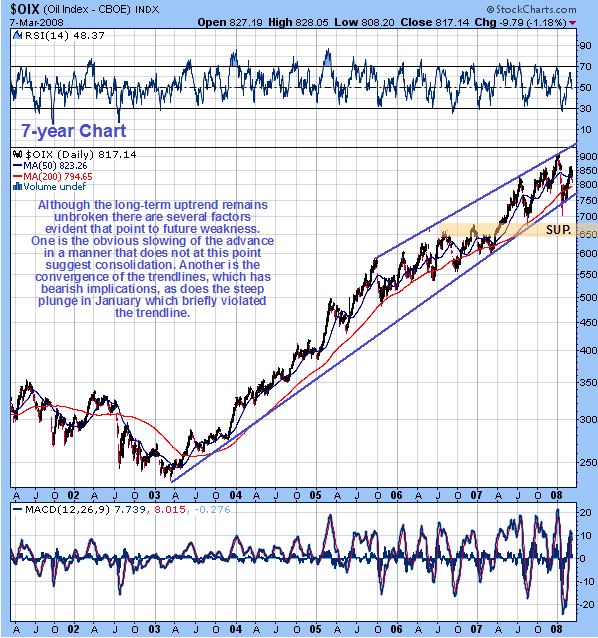 Although the long-term uptrend in oil stocks remains unbroken, as is plain to see on the 7-year chart for the OIX oil index, there are a number of factors evident which suggest that it is weakening and that a deeper correction may be looming. One obvious factor is the slowing of the advance - this index has made no net progress since mid-July, and the pattern that has formed does not at this point look like consolidation. Another factor is the convergence of the trendlines on the long-term chart, which indicates a weakening of the uptrend, although so far this is only mild. Still another is the steep plunge in January, which has bearish implications, even though it only violated the trendline on an intraday basis. As can be seen by comparing this chart with the 7-year Light Crude chart, oil stocks have noticeably underperformed oil so far this year, which is hardly surprising given the weakness of the broad stockmarket. This is the reason why we have largely avoided oil stocks in the recent past - their fortunes are much more closely linked to the broad market than Precious Metals stocks, because recession reduces the demand for oil, but does not necessarily reduce the demand for Precious Metals - on the contrary, in a time of crisis demand for Precious Metals may increase drastically. In the event of the long-term uptrend failing, the 1st stop for the index will be the zone of support in the 640 - 680 area.
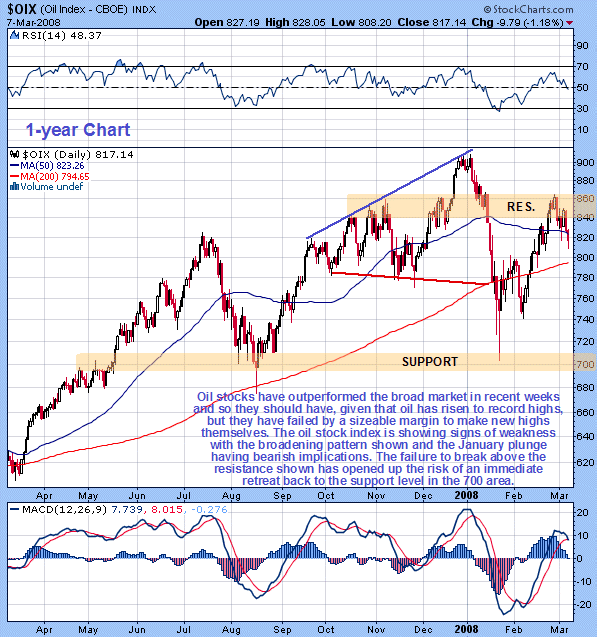 The 1-year chart for the OIX oil index shows recent action in much more detail. The most important thing to notice on this chart, as already observed on the 7-year chart, is that while oil itself has broken out to a new high over the past couple of weeks, oil stocks are clearly underperforming and have not even got close to challenging their highs at the start of the year. The reason for this, of course, is the heavy drop in the broad stockmarket since the start of the year. This illustrates an important point which is that the fortunes of oil stocks are much more closely aligned with the fortunes of the broad stockmarket than are Precious Metals stocks. So if the outlook for the broad stockmarket is grim, which it is, notwithstanding any possible near-term bounce, you are generally better off being with Precious Metal stocks than with oil stocks. The fact that the index was unable to get past the resistance near the November highs on the latest advance, let alone challenge the highs at the start of the year, is regarded as a sign of increasing weakness, particularly as the 50-day moving average is now dropping down towards the 200-day, which will soon start to level off. The broadening pattern evident from September - October and the January plunge through the 200-day moving average are also viewed as signs of increasing weakness. With the index now dropping away from the resistance zone, the risk is growing that it will continue to fall back towards the support level in the 700 area. What is written here is not intended to imply that an end to the long-term bull market in oil and oil stocks is in sight. The world is steadily running out of oil while the global population and demand for oil continues to expand. The remaining oil that has not already been squandered is set to get more and more expensive with the passage of time. There will be further discoveries and innovative technologies, of course, but costs will continue to rise and these will only put off the day of reckoning. The relatively brief corrective phase anticipated here is more the result of market convulsions and fluctuations which are normal even within a powerful bull market, although it may be exacerbated by the current acute economic crisis in the United States and its knock-on effect on the world.
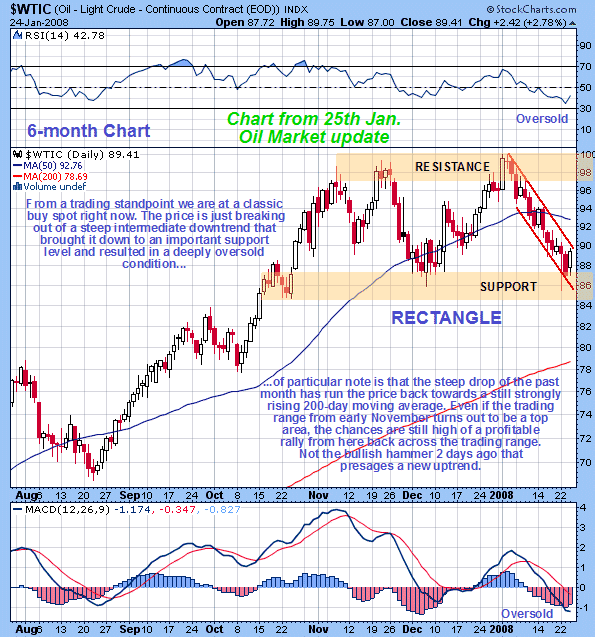
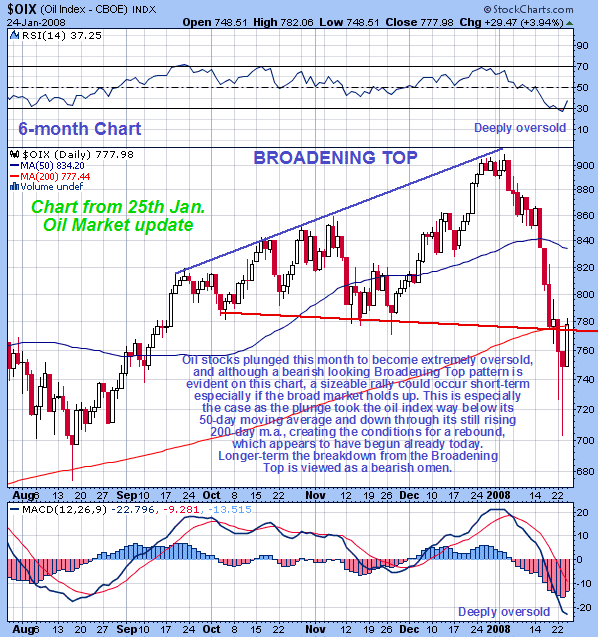 support@clivemaund.com March 11,2008 Clive Maund is an English technical analyst, holding a diploma from the Society of Technical Analysts, Cambridge and lives in Copiapo, Chile. Visit his subscription website at clivemaund.com .[You can subscribe here]. Clivemaund.com is dedicated to serious investors and traders in the precious metals and energy sectors. I offer my no nonsense, premium analysis to subscribers. Our project is 100% subscriber supported. We take no advertising or incentives from the companies we cover. If you are serious about making some real profits, this site is for you! Happy trading. No responsibility can be accepted for losses that may result as a consequence of trading on the basis of this analysis. Copyright © 2003-2008 CliveMaund. All Rights Reserved. |
| Home :: Archives :: Contact |
MONDAY EDITION December 15th, 2025 © 2025 321energy.com |
|